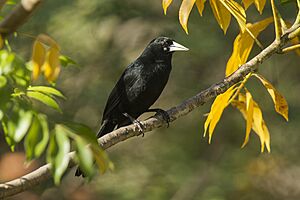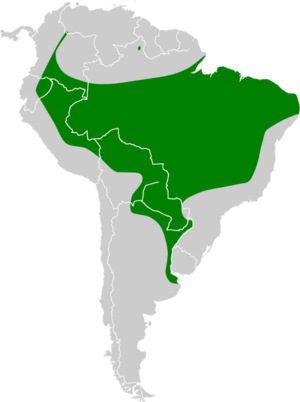Solitary cacique facts for kids
Quick facts for kids Solitary cacique |
|
|---|---|
 |
|
| Conservation status | |
| Scientific classification | |
| Genus: |
Cacicus
|
| Species: |
solitarius
|
 |
|
| Range of Cacicus solitarius | |
The solitary cacique (Cacicus solitarius) is a cool bird that lives in South America. It's also sometimes called the solitary black cacique. This bird belongs to the Icteridae family, which includes other birds like orioles and blackbirds.
You can find the solitary cacique in many countries, including Argentina, Bolivia, Brazil, Colombia, Ecuador, Paraguay, Peru, Uruguay, and Venezuela. It likes to live in warm, wet places like tropical forests and swamps. Even in areas where forests have been cut down, this bird can still be found. It's quite common and lives across a very large area. Because of this, experts at the IUCN say it's a "species of least concern", meaning it's not currently in danger.
Contents
What Does the Solitary Cacique Look Like?
The male solitary cacique is about 27 centimeters (11 inches) long. The female is a bit smaller, around 23 centimeters (9 inches). Both are completely black.
What makes this bird special is its beak! It has a big, white beak that looks like a chisel and is very pointy. This helps you tell it apart from other black birds in the same areas. Its eyes are dark, matching its feathers.
The solitary cacique also has many different calls. It often sings slowly, but sometimes its songs include funny gurgling and growling sounds.
Where Does the Solitary Cacique Live?
This bird lives across a huge part of the Amazon region. Its home stretches south all the way to northern Argentina and Uruguay. It can be found in places up to about 800 meters (2,600 feet) high.
It prefers forests, especially those along rivers (called gallery forests), and areas that get flooded. You'll usually spot it in the middle part of the trees, or down in the bushy areas. It often climbs around among thick vines.
Solitary Cacique's Life and Habits
The solitary cacique usually hangs out alone or in pairs. It doesn't join big groups of other birds. When it's looking for food, it often searches in tangled plants close to the ground. It's very flexible and can even hang upside-down! Sometimes, it will visit flowering trees higher up to find food.
What does it eat? Its diet includes small bugs and tiny animals like tree frogs. It also enjoys eating fruit and nectar from flowers.
When it's time to have babies, the solitary cacique builds its nest alone. Many other birds in the same family build their nests together in colonies, but this bird prefers to be by itself. Breeding usually happens between October and January, depending on the location. In Argentina, it's thought that they might raise two groups of chicks each year.
Is the Solitary Cacique Safe?
Yes, the solitary cacique is doing well! It lives across an incredibly large area, estimated to be about 8.79 million square kilometers (3.4 million square miles). It's a common bird, and even though we don't have exact numbers for its population, experts believe it's stable. Because of its wide range and stable numbers, the International Union for Conservation of Nature has decided that the bird's conservation status is of "least concern". This means it's not currently at risk of disappearing.


